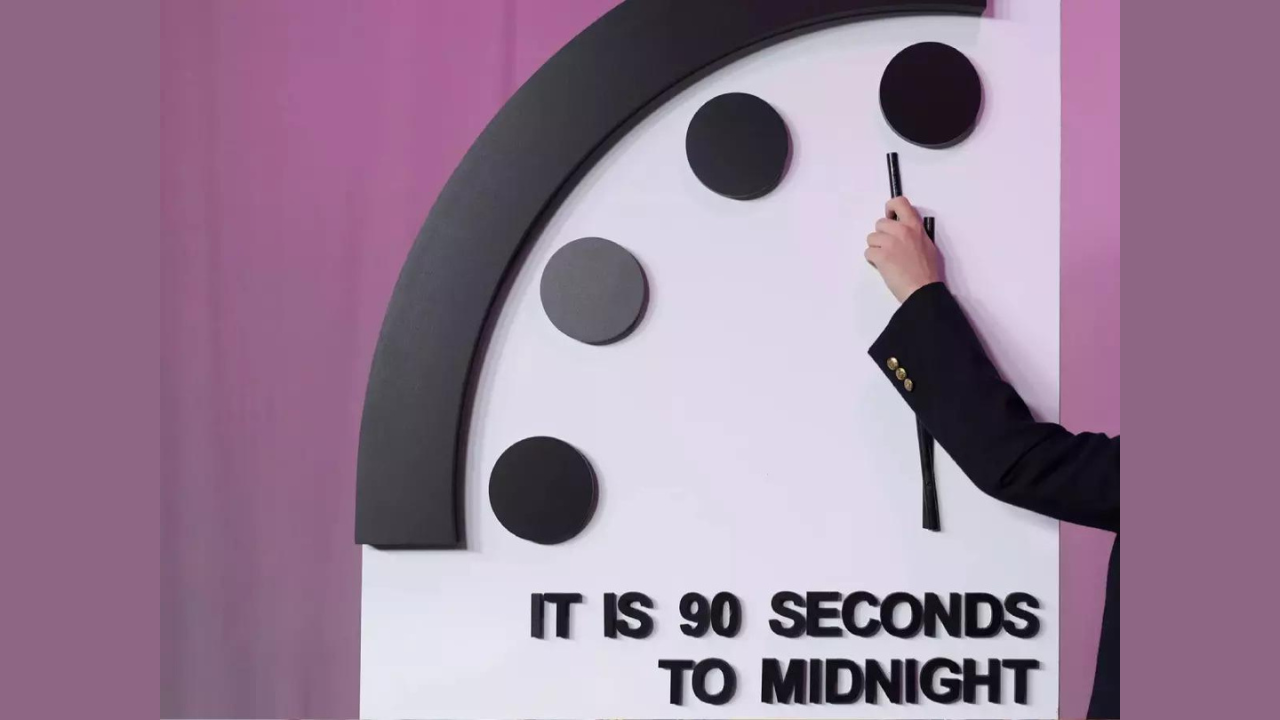NEW DELHI: The “Doomsday Clock,” a symbolic representation of humanity‘s proximity to global catastrophe, remains steadfast at a perilous 90 seconds to midnight, echoing the grave existential threats that loom over the planet. This announcement, made by the Bulletin of Atomic Scientists, underscores the urgency of the multifaceted dangers we face, including nuclear conflict, climate crises, and the uncharted waters of advanced artificial intelligence.
The Bulletin, a group founded by the architects of the atomic bomb, including Albert Einstein and J. Robert Oppenheimer, has been setting this metaphorical clock since 1947. Initially a reflection of nuclear peril, the clock now encapsulates broader existential risks. The decision to maintain the clock’s position, the closest to midnight in its over 75-year history, was influenced by a confluence of escalating global tensions and environmental degradation.
Rachel Bronson, the Bulletin’s president and CEO, expressed deep concern, stating, “Conflict hot spots around the world carry the threat of nuclear escalation, climate change is already causing death and destruction, and disruptive technologies like AI and biological research advance faster than their safeguards.” This sentiment reflects the Bulletin’s holistic approach to assessing global threats, recognizing that the challenges we face are not only interconnected but also accelerating.
The clock’s hands were last moved in 2023, primarily due to the heightened nuclear risks associated with Russia’s invasion of Ukraine. As the conflict approaches its second anniversary, the specter of nuclear warfare looms larger than ever. Moscow’s thinly veiled nuclear threats, attacks on nuclear facilities, and the erosion of international norms have all contributed to a heightened sense of global insecurity.
In addition to the nuclear predicament, the Bulletin highlighted the exacerbating climate crisis, marked by Earth’s hottest recorded year and a series of climate-related disasters. Despite some progress, such as the $1.7 trillion invested in clean energy at the climate COP in Dubai, efforts to combat climate change are deemed “grossly insufficient.” The stark contrast between clean and fossil fuel investments underscores the daunting challenge of transitioning to a sustainable future.
Moreover, the advent of generative artificial intelligence and advanced biotechnologies presents new frontiers of risk. While these technologies hold immense potential for progress, they also introduce unprecedented uncertainties about controlling forces that could either enhance or threaten civilization in myriad ways.
As the Doomsday Clock’s hands remain ominously close to midnight, the message is clear: the world stands at a critical juncture. The collective actions of nations, leaders, and individuals in the near future will determine whether we can turn back the clock or edge closer to the brink of irreversible catastrophe.
(With agency inputs)
The Bulletin, a group founded by the architects of the atomic bomb, including Albert Einstein and J. Robert Oppenheimer, has been setting this metaphorical clock since 1947. Initially a reflection of nuclear peril, the clock now encapsulates broader existential risks. The decision to maintain the clock’s position, the closest to midnight in its over 75-year history, was influenced by a confluence of escalating global tensions and environmental degradation.
Rachel Bronson, the Bulletin’s president and CEO, expressed deep concern, stating, “Conflict hot spots around the world carry the threat of nuclear escalation, climate change is already causing death and destruction, and disruptive technologies like AI and biological research advance faster than their safeguards.” This sentiment reflects the Bulletin’s holistic approach to assessing global threats, recognizing that the challenges we face are not only interconnected but also accelerating.
The clock’s hands were last moved in 2023, primarily due to the heightened nuclear risks associated with Russia’s invasion of Ukraine. As the conflict approaches its second anniversary, the specter of nuclear warfare looms larger than ever. Moscow’s thinly veiled nuclear threats, attacks on nuclear facilities, and the erosion of international norms have all contributed to a heightened sense of global insecurity.
In addition to the nuclear predicament, the Bulletin highlighted the exacerbating climate crisis, marked by Earth’s hottest recorded year and a series of climate-related disasters. Despite some progress, such as the $1.7 trillion invested in clean energy at the climate COP in Dubai, efforts to combat climate change are deemed “grossly insufficient.” The stark contrast between clean and fossil fuel investments underscores the daunting challenge of transitioning to a sustainable future.
Moreover, the advent of generative artificial intelligence and advanced biotechnologies presents new frontiers of risk. While these technologies hold immense potential for progress, they also introduce unprecedented uncertainties about controlling forces that could either enhance or threaten civilization in myriad ways.
As the Doomsday Clock’s hands remain ominously close to midnight, the message is clear: the world stands at a critical juncture. The collective actions of nations, leaders, and individuals in the near future will determine whether we can turn back the clock or edge closer to the brink of irreversible catastrophe.
(With agency inputs)


